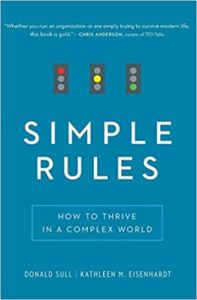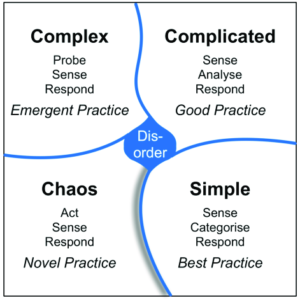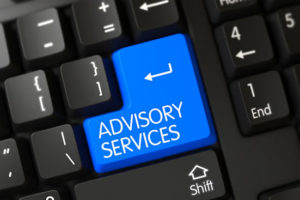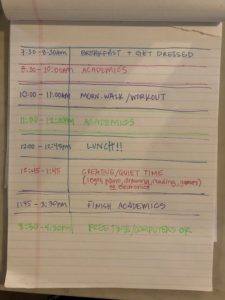Bizzaro World
Welcome to April 30, 2020. The NFL Draft kicks off in Las Vegas tonight. Can you believe they are building a stage in the Bellagio fountains? The Vegas Golden Knights are entering the second round of the NHL Playoffs on there way to Stanley Cup. The Cleveland Indians have started the season on a tear, projecting a club record 110 wins. LeBron and Anthony Davis win another championship for the Lakers.
Oh wait! Those are some of thing things which did not happen in this version of 2020. For this IT guy, I feel like I am in an episode of my life but Bizzaro World. Its stolen from the likes of Superman Bizzaro World, or one of my favorite Seinfeld episodes, The Bizzaro Jerry.


In my Bizzaro world, I do not wander outside of my makeshift office, a.k.a. dining room table. My kids have taken ownership of the office at various times of the day for their online learning activities. I am loving my commute of walking down the stairs. There is usually never any traffic at that time of the morning. Sometimes, my health care working wife (thank you for your service) is leaving at the same time. And I can’t forget to mention, the 15 steps to the kitchen for snacks and meals.
Licensing Changes
One thing that is not from this Bizzaro World is Microsoft making changes to licensing again. This time its changes to Office 365. Welcome Microsoft 365.
The recent changes were released April 21. They represent Microsoft’s vision for the future. Microsoft integrates the Microsoft Office apps with Artificial Intelligence (AI) and other cutting-edge innovations to work for small and medium sized businesses.
New Name – New Capabilities
The new name also indicates that Office is more than Word, Excel, and PowerPoint. It includes new apps like Teams, Stream, Forms, and Planner. Even the core apps now include features that often require cloud connectivity and make use of AI.
At this time when we are facing health and economic challenges, there are new capabilities in Microsoft Teams. These include hosting rich meetings and events online, cloud file storage and sharing capabilities. This enables businesses to collaborate from anywhere.
“This new approach to naming our products and the use of the Microsoft 365 brand is designed to help customers quickly find the plan they need – whether an enterprise, SMB or consumer plan,” a spokesperson said.
Many Office 365 subscriptions automatically become Microsoft 365 subscriptions:
- Office 365 Personal becomes Microsoft 365 Personal.
- Office 365 Home becomes Microsoft 365 Family.
- Office 365 Business Essentials becomes Microsoft 365 Business Basic.
- Office 365 Business Premium becomes Microsoft 365 Business Standard.
- Microsoft 365 Business becomes Microsoft 365 Business Premium.
- Office 365 Business becomes Microsoft 365 Apps for Business.
- Office 365 Pro Plus becomes Microsoft 365 Apps for Enterprise.
- Office 365 Nonprofit Business Essentials becomes Microsoft 365 Nonprofit Business Basic
- Office 365 Nonprofit Business Premium becomes Microsoft 365 Nonprofit Business Standard
There are no changes to the following Office 365 plans:
- Office 365 Enterprise Plans E1, E3, E5
- Office 365 Nonprofit Plans E1 (Donation), E3 E5
- Office 365 F1 (Firstline)
- Office 365 Education Plans A1, A3, A5
- Office 365 Government Plans G1, G3, G5
Subscription Options
If you already have existing Office 365 plans, you don’t need to do anything. Your Office 365 subscription will automatically be renamed to Microsoft 365. You will see the name of your subscription updated across your Admin Portal and monthly billing statements.
Since 2017, Microsoft 365 has been offered as a licensing bundle for enterprise customers. It provides a combination of Windows 10, Office Pro, and Enterprise Mobility and Security (EMS). These were the first SAAS offerings to include Windows 10 licensing with the subscription. It also offered EMS. This included features such as Azure Active Directory, Azure Information Protection, Microsoft Cloud App Security, Microsoft Advanced Threat Analytics, Microsoft Secure Score, and Microsoft Endpoint Manager (including Microsoft Intune and Configuration Manager).
In addition, Microsoft released Microsoft 365 plans for both home and personal use. These come with the core applications as well as online storage and cloud-connected features that let users collaborate on files in real time. These subscriptions, like all of Microsoft cloud offerings, allow users to have the latest features, fixes, and security updates along with ongoing tech support at no cost. Subscriptions can be paid for on a monthly or yearly basis. The Microsoft 365 Family plan lets users share their subscription with family members up to 6 people. They can use the apps on multiple PCs, Macs, tablets, and phones.
Want to get more information on Microsoft 365 for your organization? Contact Zunesis today.
Shattered Crystal Ball
It is April of 2020 and we are in the middle of a Pandemic. The impact of this Pandemic has changed our personal and business lives in ways we could never have imagined just weeks ago. It is far from business as usual. While we know the Pandemic will pass, we don’t know when. Moreover, we don’t have a clear picture of what the economic fallout is going to be once we start getting back to a more familiar personal and business routine.
Our Crystal Ball has rolled off the table and shattered on the floor. Still, we must plan. We can’t stay in crisis mode forever. While dealing with the challenges presented today, we need to think about the post-pandemic period. Coincident to the Pandemic, I had been researching methodologies for developing strategy, and making decisions in a complex, uncertain world. I’m still in learning and research mode but thought I’d share some of my preliminary thoughts and findings.
If we are honest with ourselves, even in a normal year our strategic plans are not free from disruption. After all, we can only plan based on our personal frame-of-reference and on what we think will happen after research and interpretation of Industry Expert predictions. None of us can know what the future holds. Even with detailed strategic plans in place, we receive new information all the time that might cause them to change. What recent events have underscored for us is that we live in a world with uncertainties. It is critical to prepare to manage our planning alongside the unknowns.
Decisions, Decisions, Decisions
When it comes to making decisions, there are multiple options. Most of us are familiar with the use of decision-making tools like Multi-attribute Utility Theory, Grid Analysis, Decision Tree, and the Pugh Method. These variations of decision matrices have been used for many years. However, these tools all assume you already have a list of options defined. You simply need to decide between them.
Decision matrices are useful, but they don’t replace strategic planning. Their design is not for responding to sudden change. To get to a point where we have well-defined options and the ability to handle change, we need frameworks in place to help us plan during normal uncertainty as well as processes for dealing with disruptive new information.
There is a lot of research on this topic. I’d like to highlight two approaches I find interesting. My goal here is not to delve deeply into either of them. I’m not qualified, and this isn’t the forum. However, I want to present these ideas as a way of sparking a conversation in your Organization. Maybe the Pandemic has caused you to think about ways you could have been better prepared for that next, “I never saw that coming” event.
Simple Rules Approach
Both the approaches I’m highlighting here are in the online version of the Harvard Business Review (HBR). The first approach I’ll discuss was published in two separate issues and is referred to by the authors as the Simple-Rules approach. The first of these articles was published in the  January 2001 Issue of HBR and was titled, “Strategy as Simple Rules”. The follow-up article was published in the September 2012 Issue and was titled, “Simple Rules for a Complex World”. In these articles, Donald N. Sull and Kathleen M. Eisenhardt summarize their research and resulting approach. Subsequent to reading the articles I found the book they co-authored on this topic as well as hours of YouTube content where each of them lectures on the Simple-Rules concept.
January 2001 Issue of HBR and was titled, “Strategy as Simple Rules”. The follow-up article was published in the September 2012 Issue and was titled, “Simple Rules for a Complex World”. In these articles, Donald N. Sull and Kathleen M. Eisenhardt summarize their research and resulting approach. Subsequent to reading the articles I found the book they co-authored on this topic as well as hours of YouTube content where each of them lectures on the Simple-Rules concept.
The Simple-Rules approach is one that is used for developing strategy or defining initiatives to meet Objectives. While not specifically intended for IT, the Simple-Rules approach can be adapted for any type of Organization. One of my takeaways from the research is that the implementation of this approach is best when using a cross-functional Team. By building a team of individuals from across Divisions and Departments in your Organization, you foster coordination, improve creativity, capture concerns and priorities that might otherwise be missed, and mitigate distrust. With the Team in place, an Organization can start crafting their Simple-Rules strategy.
Identify Your Objective
At a high level, the Simple-Rules approach requires the Team to identify their Objective. The authors also refer to these as Processes. Examples could include; improve profitability by X%, increase availability of Business-Critical Applications to achieve 100% uptime, develop critical IT initiatives to be executed over the next three years. It is important the Objective(s) are as specific as possible and that they be critical to the Organization.
With the Objective identified, the Teams’ next task is to Identify bottlenecks that would keep them from being able to achieve their Objective. Bottlenecks could be lack of trained personnel, no funding, corporate red tape, etc. Once one defines the bottlenecks, the Team develops a few simple rules for how they will overcome the bottlenecks. The authors suggest there should be no more than seven (7) rules.
The idea behind the Simple-Rules approach is to reduce complexity in the decision-making process by making the Objectives and the rules for achieving them clear, concise, and few. In a world where things happen quickly and are often unexpected, having a distilled set of objectives, and rules for meeting them, will make the decision process faster.
As part of this approach, it is important to incorporate new information on a regular basis in order to make determinations about whether your objective is still relevant, your bottlenecks still exist, or your rules still apply.
Cynefin Framework
The second approach I’ve been researching was published in the November 2007 Issue of HBR and was titled, “A Leader’s Framework for Decision Making”. The article and the approach were authored by David S. Snowden and Mary E. Boone. The authors refer to this approach as the Cynefin (kuh-NEV-in) Framework. This framework is specifically designed as a decision-making tool. And, like the Simple-Rules approach, there is a book and several YouTube resources to get a better understanding for how to apply this approach.
 The basic premise of the Cynefin Framework is that every issue will fall within a certain context. It is determined by the relationship between cause and effect. Knowing the context will shape the perspective from which you make decisions about the issue. The Cynefin Framework defines the contexts within five domains that include: Obvious, Complicated, Complex, Chaotic, and Disorder. In the article, the authors define how you determine the domain that applies to your issue and, consequently, how that domain will guide your approach for resolving your issue and making decisions.
The basic premise of the Cynefin Framework is that every issue will fall within a certain context. It is determined by the relationship between cause and effect. Knowing the context will shape the perspective from which you make decisions about the issue. The Cynefin Framework defines the contexts within five domains that include: Obvious, Complicated, Complex, Chaotic, and Disorder. In the article, the authors define how you determine the domain that applies to your issue and, consequently, how that domain will guide your approach for resolving your issue and making decisions.
Organize Thinking During Times of Change
Cynefin is a tool to help organize thinking during times of change. The instinct for many of us is to act a certain way for every problem. Or worse, we panic instead of taking time to understand that the situation may require an approach we haven’t considered. At the very least, applying this approach may help you to slow down, take a breath, analyze, and keep your mind open to an ordered, thoughtful response.
Without question, we are in uncharted waters with this Pandemic. But this isn’t the first time we’ve been faced with disruptive events, nor will it be our last. Maybe you already had a reliable process in place for handling the current situation. But if you find yourself wondering if there might be a different approach for dealing with drastic change, look at the approaches described here.
I am a firm believer that preparation can be one of the biggest contributors to positive outcomes. Having a process in place for dealing with a complex, uncertain environment won’t make an organization immune to disruption. An organization that prepares could make dealing with the disruption a little easier. So, get out your broom and dustpan, sweep up the glass, and go in search of a more stable stand for your next Crystal Ball.
Downtime Prep
Anyone else feel like we’re living the movie version of Groundhog Day. Only, there’s really nothing comical about our reality right now. This is a surreal time, but there are opportunities to take advantage of the downtime.
So that we ‘don’t let the cure be worse than the problem,’ it’s time to prep your organization’s infrastructure. When the time comes (and it will) to put that proverbial, “We’re Open” sign in the window, you will want to be prepared. We’re all hopeful this tragedy will take the shape of a ‘V’ in economic recovery. Regardless, an organization needs to be fully operational immediately.
 There are several options / assessments that should be considered depending on the size of the organization:
There are several options / assessments that should be considered depending on the size of the organization:
- IT Infrastructure
- Data Management
- Recurring Data Center Advisory Service
- VMware
- Wireless (Wi-Fi) Site Survey
- Ransomware Recovery Preparedness
- Firewall
NO CONTACT: A LOT OF THESE SERVICES CAN BE DONE BY REMOTE LOGIN
In a normal world, many organizations don’t have the time or resources to tend to the above-mentioned assessments. It’s quite possible some organizations aren’t very familiar with their environment and take it for granted. It’s very possible an organization is about to face something catastrophic with their IT environment and not even know it.
THIS IS THE TIME
Therefore, an organization needs to be ready when that bell rings in the rematch fight against the economy. Not being prepared is like showing up to a gunfight with a knife. It’s going to be hard enough already but putting in the time now to prepare for the Nation’s comeback will provide dividends.
Our Engineers will do everything possible so that an organization can be a recipient of those forthcoming dividends. In fact, they will go the extra mile every single time. Just a few days ago, I was on a call with a client and our Engineers. They were troubleshooting several issues (REMOTELY) with the client’s Backup and their Exchange. Over three hours later and well past 6PM, they found the needle in the haystack.
After checking with the client, the next day, it was really awesome to see the following reply,
“Everything is great. Backups and exchange sync worked perfectly.”
These guys are good!
While I painted the picture of rainbows and butterflies, we do realize budget is a concern. If an organization does decide to conduct one or more of the listed assessments, there are costs involved. Believe it or not, the cost to conduct some of these assessments can be significantly lower than NOT doing an assessment which could result in a complete rebuild of the organization’s infrastructure.
In some cases, this service could be provided to the client at no cost to them. That’s the tease for this blog. We currently have four or five clients who are taking advantage of this opportunity. Now is the time to prepare for the future. Downtime equals prep-time. We’re one tough country and practice the belief of:
It’s not how hard we fall; it’s how quickly we get back up and fight the fight.
Until next time, stay safe and healthy. We’re all in this together and together is the only way we will win!
Downtime Prep
Anyone else feel like we’re living the movie version of Groundhog Day. Only, there’s really nothing comical about our reality right now. This is a surreal time, but there are opportunities to take advantage of the downtime.
So that we ‘don’t let the cure be worse than the problem,’ it’s time to prep your organization’s infrastructure. When the time comes (and it will) to put that proverbial, “We’re Open” sign in the window, you will want to be prepared. We’re all hopeful this tragedy will take the shape of a ‘V’ in economic recovery. Regardless, an organization needs to be fully operational immediately.
 There are several options / assessments that should be considered depending on the size of the organization:
There are several options / assessments that should be considered depending on the size of the organization:
- IT Infrastructure
- Data Management
- Recurring Data Center Advisory Service
- VMware
- Wireless (Wi-Fi) Site Survey
- Ransomware Recovery Preparedness
- Firewall
NO CONTACT: A LOT OF THESE SERVICES CAN BE DONE BY REMOTE LOGIN
In a normal world, many organizations don’t have the time or resources to tend to the above-mentioned assessments. It’s quite possible some organizations aren’t very familiar with their environment and take it for granted. It’s very possible an organization is about to face something catastrophic with their IT environment and not even know it.
THIS IS THE TIME
Therefore, an organization needs to be ready when that bell rings in the rematch fight against the economy. Not being prepared is like showing up to a gunfight with a knife. It’s going to be hard enough already but putting in the time now to prepare for the Nation’s comeback will provide dividends.
Our Engineers will do everything possible so that an organization can be a recipient of those forthcoming dividends. In fact, they will go the extra mile every single time. Just a few days ago, I was on a call with a client and our Engineers. They were troubleshooting several issues (REMOTELY) with the client’s Backup and their Exchange. Over three hours later and well past 6PM, they found the needle in the haystack.
After checking with the client, the next day, it was really awesome to see the following reply,
“Everything is great. Backups and exchange sync worked perfectly.”
These guys are good!
While I painted the picture of rainbows and butterflies, we do realize budget is a concern. If an organization does decide to conduct one or more of the listed assessments, there are costs involved. Believe it or not, the cost to conduct some of these assessments can be significantly lower than NOT doing an assessment which could result in a complete rebuild of the organization’s infrastructure.
In some cases, this service could be provided to the client at no cost to them. That’s the tease for this blog. We currently have four or five clients who are taking advantage of this opportunity. Now is the time to prepare for the future. Downtime equals prep-time. We’re one tough country and practice the belief of:
It’s not how hard we fall; it’s how quickly we get back up and fight the fight.
Until next time, stay safe and healthy. We’re all in this together and together is the only way we will win!
A New Routine
The morning alarm is still ringing, and the scramble to get to work on time is real for me. However, now the kids are in the living room on laptops. I have made an office in the bedroom. My new name is Ms. Mommy. I offer advice in trying to keep your daily routine as healthy as possible. In addition, some tips to make it through the day without an anxiety attack as you embrace the 2020 homeschool in a global pandemic.
I have invented entirely new courses, like “Honors Laundry,” “AP Vacuuming,” and “Cat Litter Box Cleaning and Fine Scooping Skills 101.” With love and support, I write to encourage (mostly myself) and others that this new way of life is possible if we stop to find humor, beauty, and the lessons in all of this.
Building a sales pipeline of business is no easy task. It takes time to build those relationships, to learn about their wants needs and budget constraints. One must prove their tenacity, steadfastness, and determination to win the sale and all while the economy is moving, this has its uphill battles. Now imagine trying to build that pipeline while businesses have closed, employees are laid off, and we have all been quarantined. This is all still easier than homeschooling two elementary kids!
Schedules: Structured Routine
Mean Ms. Mommy promises you that all children, even the middle-aged ones love routine. Keeping to a schedule that is close to one similar to the school day will help the littles, and yourself get through the next 60 days of the school year at home. Here is our daily schedule that guides us to the glorious hour known as HAPPY.

Now that we have the schedule in place let’s talk about TED. It is an excellent resource to engage the kids on all sorts of topics. Most schools have sent home curriculum to keep the kids learning on track, but who couldn’t benefit from a TED talk?
Parents aren’t all alone when it comes to thinking up educational content for their kids.
Here are a few resources:
- Scholastic is offering free online resources and activities.
- NASA’s Kids’ Club has space games and learning modules for the younger crowd
- Technology Projects for Kids
- 8 First Projects to Get Students Using Technology
- HPE’s Activity Guide
Stay Connected
Staying connected is essential for human social growth. We’ve slowly distanced ourselves over the years because of technology with the ability to text instead of call or IM instead of writing a letter. Now that same technology that kept us apart is bringing us back together. We have been chatting with grandma over Zoom and setting up play dates with friends in Google Hangout. My family’s most favorite way to spend time with friends has been Messenger Kids. Messenger Kids connects through Facebook. Once set up, they can open the app and try calling friends (at the appropriate scheduled time) by themselves. That’s the bonus for Ms. Mommy, who can keep working on building pipeline instead of explaining how to use the address bar.
Stay Healthy
Aside from work, school, virtual playdates, staying healthy is always a challenge. In these last few weeks, I watched my daughter become more engaged with exercise than ever before (because I’ve negotiated with the little terrorist for iPad time). Before I built a sales pipeline for a living, I was a fitness instructor. I was always working out in my home studio. I came up with new routines, and my daughter would watch. Now that we have been doing everything as a family, she is bicep curling with the rest of us. She even participates in some live Facebook workouts.
The lesson worth sharing here is that there are only 60 more days left of homeschooling, and you can survive anything for 60 days! During this time, we have had to find new ways to live, learn, and communicate.
Now that Grandma is on TikTok and has more likes than you, it’s time to reflect and take a breath. Find the value in the last slice of bread, reusing a Ziplock bag, and using less toilet paper from here on out (that shortage was no joke)!
As our consumer society quickly came to a halt and conservation of items set in, so has the normal of working and homeschooling from home. I offer some advice from a working mom educating two young kids at home:
- Keep to a schedule that has been in place year after year. Routine is key. You can do it! Get out of those pajamas and get everyone moving before 8 am.
- Spend time to find new sources of educational enjoyment. Googling “How to make fractions easy” is a real search. You are not alone.
- Stay connected to friends and family with the incredible technology we have out there today.
- Most importantly, get out and walk around the block, holding a gallon of water in both hands, do a few lunges, and breathe deep and with intention!
Working Remote
We live in a time (thankfully) where information is at our fingertips. Data can be transmitted and received from almost anywhere. And nearly all personal, and business-related, applications can be accessed remotely. As our world, our workloads, and our needed cache of data, rapidly expands; remote-accessibility has added a huge amount of flexibility.
But what if you had no other choice? The recent Coronavirus Pandemic has shown that this possibility can quickly become a reality. Let me take you on a quick little journey that should assuage any apprehension you may have about “working remote”.
The Past:
Business operates in a central office building or workspace. Employees travel to the office and operate there for the entirety of the workday. Remote work can be done for catch-up, and occasional work-from-home days are allowed. The majority of duties are conducted in the office.
The Present:
More and more companies operate a remote business model. Some businesses need to adapt a work-from-home option due to acts of nature or different unforeseen factors. While others have dissolved their office space entirely and now strictly have employees work in a remote fashion.
The Future:
Now here comes the tricky part. Where do we go from here? At the onset of the COVID-19 Pandemic, many places of business had to unexpectedly move their employees to remote functions without the means to do so. Being a technology company, Zunesis is still seeing this daily. It is an ongoing process but thankfully there are a lot of tools and services out there to help (more on that in a minute).
Some organizations may see the value and cost-reduction of moving day-to-day functions out of office buildings and into people’s homes.
What else is in store when the world begins to stabilize?
When are we all allowed to go “back to normal”?
Or is working from home “the new normal”?
The truth is…we don’t know.
 But either way, here’s a few things we DO know:
But either way, here’s a few things we DO know:
- Aruba Networks is working tirelessly to assist both corporate facilities and their newly delegated remote employees with deploying one unified network for company access.
a) With Aruba Central (Aruba’s Cloud-based management platform) a newly designed cloud gateway feature now allows organizations the ability to make their mission-critical applications remotely accessible to employees working from home or offsite locations. - Aruba has also put measures in place to help extend network coverage from data centers out to remote sites or emergency pop-up locations. This is done by using a wireless mesh solution and outdoor access points.
Zunesis has made the implementation and deployment of these solutions (and others) much easier for our customers. We are partnering with Aruba solutions architects and ensuring our in-house networking engineers are readily available.
For more information on Aruba’s strategy or Zunesis’ remote access solutions please visit the links below.
Zunesis Remote Access Solutions
In the meantime…live long and prosper, my friends. We are all in this together!




